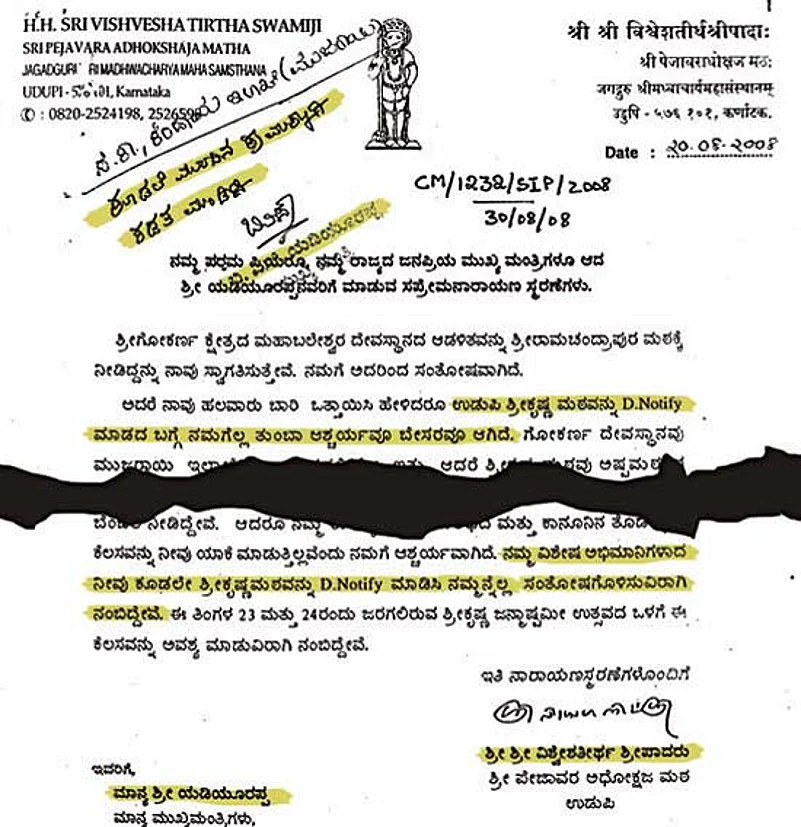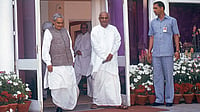After The Idol
- On October 20, the Yediyurappa government denotified the 9th century Krishna temple in Udupi and handed it over to the Ashta maths (eight seminaries) of the Madhava sect of Brahmins
- This was done at the instance of the Pejawara, Sri Vishvesha Tirtha Swamiji, a leading light of the Ayodhya movement
- In 1961, the SC had ruled that the temple was not a math
- The temple denotification is politically volatile—the backward Kuruba (shepherds) community has a major claim on it
***
Till now, the muck raked up against Karnataka chief minister B.S. Yediyurappa pertained to his brazen acts of denotifying land illegally to favour his family and friends. But now this saga of denotification by this first BJP government in the south has unambiguously taken on a sectarian/casteist shade.
On October 20, 2010, the Yediyurappa government denotified the revered 9th century Krishna temple in Shivalli of Udupi taluk and handed it over to the Ashta maths (eight seminaries) of the Madhava sect of Brahmins. In effect, a public temple controlled by the state muzrai department was ceded and placed under the supremely orthodox seminaries, an act which not only violates a Supreme Court judgement of 1961 but also pits a powerful Brahmin sect against the rest of the Hindus in the state.
From the documents accessed by Outlook, this appears to have happened at the instance of the Pejawara seer, Sri Vishvesha Tirtha Swamiji, a leading light of the Ayodhya movement and a spiritual guru to several Sangh leaders, including L.K. Advani and Uma Bharati. His ally in the government is ex-home minister and current higher education minister V.S. Acharya, who holds additional charge of the religious endowments department. Interestingly, a few days ago when there was a crescendo across the state for Yediyurappa’s resignation, Vishvesha Tirtha Swamiji was one of those who had openly argued for his continuance in office. Is it any surprise then that some see this as a quid pro quo measure?

Yediyurappa with the Pejawar seer at the Vishwa Tulu sammelan, 2009
In a letter dated August 20, 2010, the Swamiji writes in a conspiratorial whisper to Acharya: “On the Krishna math denotification issue, Yediyurappa is not aware of anything. He is willing to help Krishna math. Suresh Kumar (the law minister) is also not aware of anything. He will also be helpful. Now this matter is fully in your hands. As muzrai minister, if you denotify Krishna math the eight seminaries and the people of Udupi will always remember you. The time is ripe. The CM’s on our side. There is no opposition. Do the needful and be remembered forever. That will make the pontiffs of the eight seminaries happy.”
On the same day, he writes to Yediyurappa and keeps an intriguing tone: “Although I have asked you to D.Notify (sic) the Krishna math many times, you have surprised me and saddened me by not doing so...we have always been proud of you and have given you our support right from the beginning. Since you are our very special admirer, we expect you to D.Notify Krishna math and make us happy.” Two months later, the chief minister denotifies the temple.
Prior to this, as early as August ’08 (within three months of coming to power) Acharya had written to the CM asking him to pass orders to denotify the Krishna temple “erroneously notified” under the Karnataka Hindu Religious Institutions and Charitable Act, 1997, by some “ignorant” officials. He says he has also attached a letter written by the swamiji in this regard. Yediyurappa, on October 30, ’08, makes a noting on the letter asking for the file to be presented before him so that action could be taken. If one reads this letter with the August 2010 letter of the swamiji, it appears like a stern warning or a reminder to the CM.
Why the chief minister took over two long years after it was first requested should explain the complexity and sensitivities involved in the matter.
First the legal complexities: as far back as December 1961, the Supreme Court had ruled that this was a temple and not a math as the pontiffs claim it to be. The court said it belonged to all Hindus and there was no evidence to prove that the temple was originally founded for the private use of Sri Madhavacharya (the 13th century seer) and his disciples or the maths he established. The SC commented that “the evidence on record is fully consistent in the findings of the courts below that this is a place dedicated to the Hindu public and is used by them as a place of public religious worship. It is not disputed that a large number of pilgrims from all over the country visit this place, take part in the worship there, make offerings to the deity and receive the prasad. The institution also received monetary aid from the state.”

Aug 2008 letter from the seer to the CM seeking denotification of the Krishna temple. The CM’s go-ahead to the muzrai department noted on top left.
Besides, the Congress regime in April 2003 had passed an order bringing the Krishna temple and two older ones (Anantheswara and Chandramouleshwara temples) in its vicinity under the ambit of the muzrai department. This was challenged again by the pontiffs in Udupi and the matter is pending before the civil court there. But the Yediyurappa government, instead of waiting for a court verdict, went ahead and denotified it, throwing all propriety to the winds.
Advocate Manjunath Lakavalli, whose rti application on the issue yielded the shocking results of subversion of the system, says: “If one goes through the file movement, it is clear that they first made the decision to denotify and then sent it back to the revenue officials and the law department to approve and comply with it. It is also clear that the officials have diligently reminded the government about the pending case as well as the SC order. Yet, they brazenly went ahead and denotified the temple.”
Manjunath adds: “It is surprising why the maths don’t ask for the two other temples in the vicinity to be denotified although they pre-date the Krishna temple by at least a couple of hundred years. In fact, the Anantheswara temple is very important as it has a statue of Sri Madhavacharya. The reason is simple. The Krishna temple is a cash cow. The maths are interested in the Rs 3 crore revenue it generates annually.”
Besides the legal aspect, what makes this denotification a political hot potato is the fact that the backwards, especially the Kuruba (shepherds) community, the third largest in the state, has a major claim on the temple. They associate it with Kanakadasa, the 16th century mystic. It is widely believed that Lord Krishna turned around to give darshan to the Kuruba composer and mystic when the Brahmins denied him entry into the temple. So the recent denotification, which makes the temple an exclusive preserve of one Brahmin sect, is naturally fodder for a clash between various interests. Already, on November 16, backward class and Dalit organisations had gathered in huge numbers in Udupi to register their protest against the denotification.
On August 14, 2008, in a similar act, the BJP government had handed over the ancient temple in Gokarna to the Ramachandrapura math. The Sangh parivar has often been spoken of as a preserver of our culture and heritage, but does that imply that it should privatise places of worship?


























